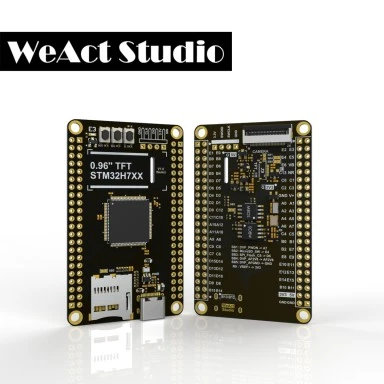WeAct Studio MiniSTM32H743 Core Board
Overview
The MiniSTM32H743 Core board is a compact development board equipped with an STM32H743VIT6 microcontroller. It features a variety of peripherals, including a user LED and button, a display, and external SPI and QuadSPI NOR flash memory.
Key Features
STM32 microcontroller in LQFP100 package
USB OTG or full-speed device
1 user LED
User, boot, and reset push-buttons
32.768 kHz and 25MHz HSE crystal oscillators
External NOR Flash memories: 64-Mbit Quad-SPI and 64-Mbit SPI
- Board connectors:
Camera (8 bit) connector
ST7735 TFT-LCD 160 x 80 pixels (RGB565 3-SPI)
microSD™ card
USB Type-C Connector
SWD header for external debugger
2x 40-pin GPIO connector

MiniSTM32H743 Core Board (Credit: WeAct Studio)
More information about the board can be found on the Mini_STM32H743 website.
Hardware
The MiniSTM32H743 Core board provides the following hardware components:
STM32H743VIT6 in LQFP100 package
ARM 32-bit Cortex-M7 CPU with FPU
Chrom-ART Accelerator
Hardware JPEG Codec
480 MHz max CPU frequency
VDD from 1.62 V to 3.6 V
2 MB Flash
~1 MB SRAM
High-resolution timer (2.1 ns)
32-bit timers(2)
16-bit timers(10)
SPI(6)
I2C(4)
I2S (3)
USART(4)
UART(4)
USB OTG Full Speed and High Speed(1)
USB OTG Full Speed(1)
CAN FD(2)
SAI(4)
SPDIF_Rx(4)
HDMI_CEC(1)
Dual Mode Quad SPI(1)
Camera Interface
GPIO (up to 82) with external interrupt capability
16-bit ADC(3) with 16 channels
12-bit DAC with 2 channels(2)
True Random Number Generator (RNG)
16-channel DMA
LCD-TFT Controller with XGA resolution
More information about STM32H743 can be found here:
Supported Features
The mini_stm32h743 board configuration supports the following hardware features:
Interface |
Controller |
Driver/Component |
|---|---|---|
NVIC |
on-chip |
nested vector interrupt controller |
WDT |
on-chip |
watchdog |
PINMUX |
on-chip |
pinmux |
FLASH |
on-chip |
flash memory |
GPIO |
on-chip |
gpio |
SPI |
on-chip |
spi |
QSPI NOR |
on-chip |
off-chip flash |
SDMMC |
on-chip |
disk access |
DISPLAY |
on-chip |
display |
Other hardware features have not been enabled yet for this board.
The default configuration per core can be found in the defconfig file:
boards/weact/mini_stm32h743/mini_stm32h743_defconfig
Pin Mapping
MiniSTM32H743 Core board has 5 GPIO controllers. These controllers are responsible for pin muxing, input/output, pull-up, etc.
For more details please refer to Mini_STM32H743 website.
Default Zephyr Peripheral Mapping:
The MiniSTM32H743 Core board is configured as follows
USER_LED : PE3
USER_PB : PC13
SPI1 SCK/MISO/MOSI/NSS : PB3/PB4/PD7/PD6 (NOR Flash memory)
SPI4 SCK/MOSI/NSS : PE12/PE14/PE11 (LCD)
QuadSPI CLK/NCS/IO0/IO1/IO2/IO3 : PB2/PB6/PD11/PD12/PE2/PD13 (NOR Flash memory)
SDMMC1 CLK/DCMD/CD/D0/D1/D2/D3 : PC12/PD2/PD4/PC8/PC9/PC10/PC11 (microSD card)
USB DM/DP : PA11/PA12 (USB CDC ACM)
System Clock
The STM32H743VI System Clock can be driven by an internal or external oscillator, as well as by the main PLL clock. By default, the System clock is driven by the PLL clock at 240MHz. PLL clock is fed by a 25MHz high speed external clock.
Serial Port (USB CDC ACM)
The Zephyr console output is assigned to the USB CDC ACM virtual serial port. Virtual COM port interface. Default communication settings are 115200 8N1.
Programming and Debugging
The MiniSTM32H743 Core board facilitates firmware flashing via the USB DFU bootloader. This method simplifies the process of updating images, although it doesn’t provide debugging capabilities. However, the board provides header pins for the Serial Wire Debug (SWD) interface, which can be used to connect an external debugger, such as ST-Link.
Flashing
To activate the bootloader, follow these steps:
Press and hold the BOOT0 key.
While still holding the BOOT0 key, press and release the RESET key.
Wait for 0.5 seconds, then release the BOOT0 key.
Upon successful execution of these steps, the device will transition into bootloader mode and present itself as a USB DFU Mode device. You can program the device using the west tool or the STM32CubeProgrammer.
Flashing an application to MiniSTM32H743
Here is an example for the Hello World application.
First, put the board in bootloader mode as described above. Then build and flash
the application in the usual way. Just add CONFIG_BOOT_DELAY=5000 to the
configuration, so that USB CDC ACM is initialized before any text is printed,
as below:
# From the root of the zephyr repository
west build -b mini_stm32h743 samples/hello_world -- -DCONFIG_BOOT_DELAY=5000
west flash
Run a serial host program to connect with your board:
$ minicom -D <tty_device> -b 115200
Then, press the RESET button, you should see the following message after few seconds:
Hello World! mini_stm32h743
Replace <tty_device> with the port where the board XIAO BLE
can be found. For example, under Linux, /dev/ttyACM0.
Debugging
This current Zephyr port does not support debugging.
Testing the LEDs in the MiniSTM32H743
There is a sample that allows to test that LED on the board are working properly with Zephyr:
# From the root of the zephyr repository
west build -b mini_stm32h743 samples/basic/blinky -- -DCONFIG_BOOT_DELAY=5000
west flash
You can build and flash the examples to make sure Zephyr is running correctly on your board. The LED definitions can be found in boards/weact/mini_stm32h743/mini_stm32h743.dts.
Testing shell over USB in the MiniSTM32H743
There is a sample that allows to test shell interface over USB CDC ACM interface with Zephyr:
# From the root of the zephyr repository
west build -b mini_stm32h743 samples/subsys/shell/shell_module -- -DCONFIG_BOOT_DELAY=5000
west flash
